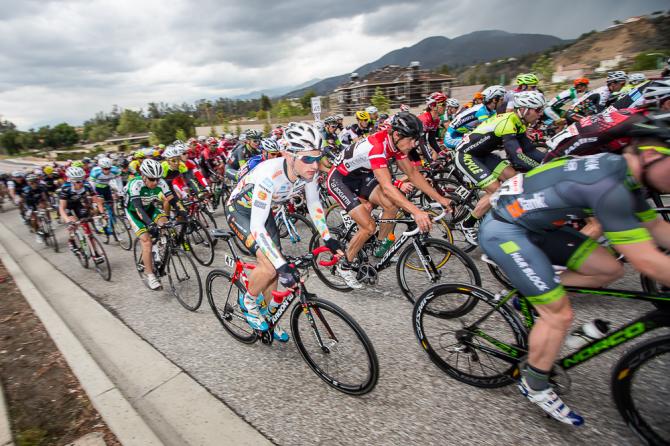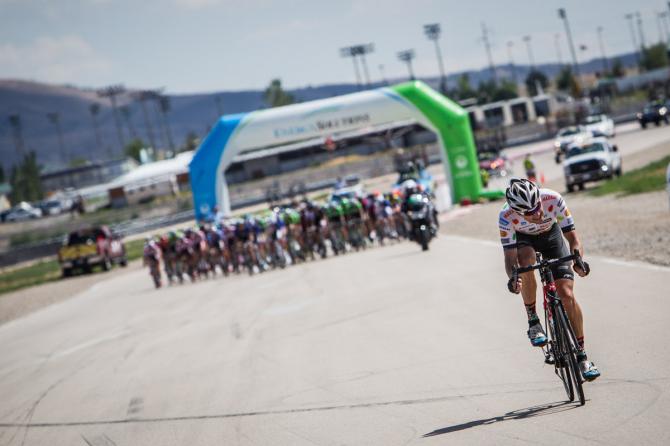Jacob Rathe Blog: The long road back to the start line
American continues recovery from iliac artery surgery


It was this year at the Redlands Bicycle Classic when I realised the 2015 season would be far different than I expected.
I spent the offseason trying to fix my bad leg. I was in the gym doing physical therapy and strength training five days a week. There was progress; I hadn't experienced any horrific sensations like I used to in training. Instead, I had some strange symptoms, such as a heavy leg after traveling and significantly worse recovery after consecutive days of training. It didn't make sense to my physical therapist. At that point, I just accepted that I had to deal with it.
During the second stage of Redlands, however, everything suddenly made sense. It was a 90-minute drive to the time trial at Big Bear Lake - the first ingredient in what proved to be a disastrous combination. I arrived at the TT with a heavy left leg and went through my stretching and massage routine of loosening it up. But five minutes into the solo effort, in the crouched, aerodynamic position, and I had the same cramping pain in my quadricep that I thought I had fixed. I finished near 80th place.
On the drive back I pondered how I would quit racing and what I would do. How much do I have to race and still get paid? What do normal people do during the day?
By sheer luck that evening I overheard a conversation between teammates about Iliac Artery Endofibrosis (IAE). 'How do you spell that?' I asked, and immediately Googled it. IAE is the narrowing and kinking of the Iliac Artery, reducing blood flow into the leg, and it can be influenced by posture. That's why it hurts at high intensities. That's why it doesn't travel well. That's why it is especially bad in a low time trial position. Five minutes later I was confidently self-diagnosed, as with most people I've spoken with are.
IAE and I met, and it was kismet.

Jacob Rathe hopes to be back in front of the peloton next year. (Jonathan Devich)
Self-diagnosis may not be quite the right word. IAE isn't the first thing someone thinks of when things aren't quite right, but it's the only possibility left once every other option has been eliminated. As for me, being diagnosed 100 per cent by a doctor wasn't devastating, or joyful for that matter, but it provided a satisfying closure of knowing that there is a specific and effective solution to this problem.
The symptoms are confusing, and to add to that they aren't always the same. The more typical symptoms are a dead feeling in the leg with numbness. I had a terrible cramping pain in my leg and severe muscular imbalances all over my body, creating a breadcrumb of problems that were really just symptoms. I felt like a detective trying to catch an elusive criminal, and I finally did.
Equally confusing as the diagnosis is the cause of it to begin with. It is most common in cyclists, but occurs in other athletes such as speed skaters, cross country skiers and runners. Considering those sports, repetitive hip flexion is the likely culprit. Doctors haven't really proven what causes IAE, but there are three theoretical contributing factors: high rate of blood flow, hypertrophied muscles in the abdomen tethered to the artery, and the bend in the artery in the cycling position.
Imagine a poor, little artery getting pushed on and bent for years and years, easily thousands of hours. Is it surprising that it shrinks from the size of a dime to the size of a Slurpee straw? The walls of the artery thicken with tissue buildup, from the inside and out. The physical manifestation is alarming.
Why this happens is a good question with a reasonable theory, but a better question is why do some people get it and others don't?
People have been hearing about IAE more and more. With that comes the illusion that more people are actually getting the disease. Why do you think more people are getting it? Maybe it is from gluten? I have no data and I'm not a scientist, but a strong guess would be that increased diagnoses are in line with the increased awareness.
I've been riding the bike again, almost to a level that feels like training. Upon pedaling easy there is a subtle spark of energy. Like the swift firing of a piston, as opposed trying to use an al dente noodle as a pogo stick. Several times I thought I fixed this problem, so it doesn't seem believable that it is actually gone. Safe to say, though, that something drastic happened; there is far too big of a scar for there to be any chance of placebo effect.
At the end of the first month, I noticed my leg didn't get heavy after multi-hour drives. That was a good sign. The two real tests were in the middle of October when I went to Hong Kong for a criterium - the travel as well as the race were indicators. It didn't really make sense to travel around the world for a one-hour race when I should've been training, but it was a test. If I had the same problem, I could quit the sport and get on with my life.
I raced under the lights of Hong Kong, along the ocean, in the middle of one of the most spectacular cities in the world. I didn't see any of it, I was suffering. Crits are hard even when I'm fit. My weak leg was burning like a normal leg does, and I fought through it with joy.
Twenty-four-year-old Jacob Rathe was diagnosed with Iliac Artery Endofibrosis after more than two years of struggling with cramping and pain in his left leg. The former Garmin-Sharp rider, who now competes for Jelly Belly-Maxxis, underwent surgery on June 27 to correct the problem, which has affected more and more professional cyclists such as Joe Dombrowski, Mike Friedman and Stuart O'Grady. Rathe will keep Cyclingnews readers updated on the progress and struggles of his recovery as he attempts to regain the form that led him to the WorldTour at 21.
Get The Leadout Newsletter
The latest race content, interviews, features, reviews and expert buying guides, direct to your inbox!
Twenty-four-year-old Jacob Rathe was recently diagnosed with Iliac Artery Endofibrosis after more than two years of struggling with cramping and pain in his left leg. The former Garmin-Sharp rider, who now competes for Jelly Belly-Maxxis, underwent surgery on June 27 to correct the problem, which has affected more and more professional cyclists such as Joe Dombrowski, Mike Friedman and Stuart O'Grady. Rathe will keep Cyclingnews readers updated on the progress and struggles of his recovery as he attempts to regain the form that led him to the WorldTour at 21 years old.